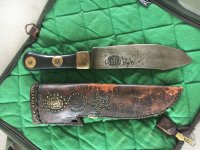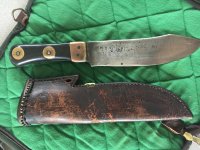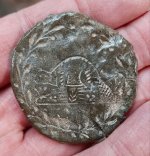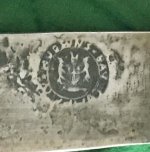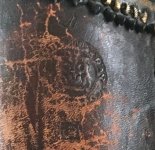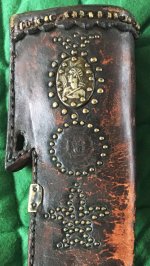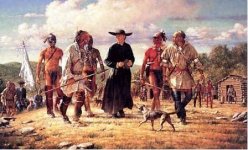I have not been able to find info on this. Any help would be greatly appreciated.
Navigation
Install the app
How to install the app on iOS
Follow along with the video below to see how to install our site as a web app on your home screen.
Note: This feature may not be available in some browsers.
More options
You are using an out of date browser. It may not display this or other websites correctly.
You should upgrade or use an alternative browser.
You should upgrade or use an alternative browser.
Hudson’s bay knife with sheath
- Thread starter Kavik67
- Start date
DizzyDigger
Gold Member
- Dec 9, 2012
- 6,420
- 13,062
- Detector(s) used
- Nokta FoRs Gold, a Gold Cube, 2 Keene Sluices and Lord only knows how many pans....not to mention a load of other gear my wife still doesn't know about!
- Primary Interest:
- Prospecting
Kavik, first off, welcome to the site..
What you have there is a gorgeous Hudson Bay knife designed
for skinning beaver. Made and sold by the Hudson Bay company
from the 1830's up through the 1890's. They were made for
Hudson Bay by Wolstenholm & Sons of Sheffield England.
I don't know if the sheath is original, or not. It's certainly
correct for the knife
Thank you for sharing it with us...If that was mine, I would
consider it a treasure.

What you have there is a gorgeous Hudson Bay knife designed
for skinning beaver. Made and sold by the Hudson Bay company
from the 1830's up through the 1890's. They were made for
Hudson Bay by Wolstenholm & Sons of Sheffield England.
I don't know if the sheath is original, or not. It's certainly
correct for the knife
Thank you for sharing it with us...If that was mine, I would
consider it a treasure.

Last edited:
Upvote
0
- Jun 8, 2006
- 6,286
- 8,912
- Detector(s) used
- Whites, Minelab, Tesoro, and custom machines
- Primary Interest:
- Metal Detecting
Great knife an good ID!! Is indeed a treasure! Welcome to Tnet
Upvote
0
What a beautiful looking knife Kavik... welcome to Tnet. 
Great information provided by Mike above as well.
This knife would be considered very collectible anywhere in North America.
Based on the fleur-de-lis and the maker's mark on the back (which is similar to the markings on the knife), I'm thinking the sheath is original to the knife and was likely owned by someone in Quebec.
If you like, I'll post your knife on a Canadian detecting site to see what the members in Quebec think about it?
Just for fun, here's an early hand-carved horse rosette I found a few years ago featuring a beaver.
Dave

Great information provided by Mike above as well.
This knife would be considered very collectible anywhere in North America.

Based on the fleur-de-lis and the maker's mark on the back (which is similar to the markings on the knife), I'm thinking the sheath is original to the knife and was likely owned by someone in Quebec.
If you like, I'll post your knife on a Canadian detecting site to see what the members in Quebec think about it?
Just for fun, here's an early hand-carved horse rosette I found a few years ago featuring a beaver.
Dave
Attachments
Last edited:
Upvote
0
- May 9, 2012
- 24,067
- 82,044
- Primary Interest:
- Other
Fantastic piece!
"H.B. Camp Knife".
"Eye" knife.
"Buffalo knife".
Seventeen hundreds references, but Hudson Bay really popularized it.
I don't have my sources at hand ...Descriptions exist from old writings. One described it as a pointed cleaver.
Used to break down game , but in the hands of an experienced used could do much finer tasks.
There's always the fun of if you could only have "one knife" debates.
The H.B. would certainly cover a heavy knife desire . From camp chores and butchering , to hacking through brush if needed. Digging holes, (Ouch) and a host of other uses.
The "eyes" were recognized. Over quite a range , so it's been written anyways.
"H.B. Camp Knife".
"Eye" knife.
"Buffalo knife".
Seventeen hundreds references, but Hudson Bay really popularized it.
I don't have my sources at hand ...Descriptions exist from old writings. One described it as a pointed cleaver.
Used to break down game , but in the hands of an experienced used could do much finer tasks.
There's always the fun of if you could only have "one knife" debates.
The H.B. would certainly cover a heavy knife desire . From camp chores and butchering , to hacking through brush if needed. Digging holes, (Ouch) and a host of other uses.
The "eyes" were recognized. Over quite a range , so it's been written anyways.
Upvote
0
old digger
Gold Member
- Jan 15, 2012
- 7,512
- 7,352
- Detector(s) used
- White's MXT
- Primary Interest:
- All Treasure Hunting
Fantastic Knife!  We have one of those different striped Hudson Bay blankets. My wife used it as child when she a lot younger. It is still in excellent condition.
We have one of those different striped Hudson Bay blankets. My wife used it as child when she a lot younger. It is still in excellent condition.
Upvote
0
gunsil
Silver Member
- Dec 27, 2012
- 3,863
- 6,207
- Detector(s) used
- safari, ATPro, infinium, old Garrett BFO, Excal, Nox 800
- Primary Interest:
- All Treasure Hunting
Way too big for skinning beaver. These were considered "camp knives" for general camp use and are heavily faked or reproduced. I would send photos to Bernard Levine for authentication since there are many fakes out there. The blade on this one looks artificially aged and the handle shows no use. How thick is the blade? He is America's leading knife expert, you can google his contact info. Beaver skinning knives usually have 3-4" blades. Where did you get it? Sorry for being skeptical but there are just too many fake HB knives out there and the sheath does not look good for the period. I have never seen an HB knife made by Wostenholm. It will probably cost $25 for Bernard's appraisal but well worth knowing if it is period or a modern repro.
Last edited:
Upvote
1
- May 9, 2012
- 24,067
- 82,044
- Primary Interest:
- Other
Upvote
0
DizzyDigger
Gold Member
- Dec 9, 2012
- 6,420
- 13,062
- Detector(s) used
- Nokta FoRs Gold, a Gold Cube, 2 Keene Sluices and Lord only knows how many pans....not to mention a load of other gear my wife still doesn't know about!
- Primary Interest:
- Prospecting
Way too big for skinning beaver. These were considered "camp knives" for general camp use and are heavily faked or reproduced. I would send photos to Bernard Levine for authentication since there are many fakes out there. The blade on this one looks artificially aged and the handle shows no use. How thick is the blade? He is America's leading knife expert, you can google his contact info. Beaver skinning knives usually have 3-4" blades. Where did you get it? Sorry for being skeptical but there are just too many fake HB knives out there and the sheath does not look good for the period. I have never seen an HB knife made by Wostenholm. It will probably cost $25 for Bernard's appraisal but well worth knowing if it is period or a modern repro.
Kavik didn't say how long the blade was, and in my younger days
I skinned many a beaver with a knife of that same design. A 6 inch
blade would be about the limit for a beaver skinner, and I didn't
consider that this blade could be much longer.
Nothing wrong with being skeptical; good suggestion on the eval. by a
professional..hoping it's the real deal..
Upvote
0
Way too big for skinning beaver. These were considered "camp knives" for general camp use and are heavily faked or reproduced. I would send photos to Bernard Levine for authentication since there are many fakes out there. The blade on this one looks artificially aged and the handle shows no use. How thick is the blade? He is America's leading knife expert, you can google his contact info. Beaver skinning knives usually have 3-4" blades. Where did you get it? Sorry for being skeptical but there are just too many fake HB knives out there and the sheath does not look good for the period. I have never seen an HB knife made by Wostenholm. It will probably cost $25 for Bernard's appraisal but well worth knowing if it is period or a modern repro.
I respect your opinion and experience gunsil, I also realize you're not suggesting this knife is a reproduction. But when I take a close-up look at the pics provided by Kavik, I can see none of the tell-tail signs that this piece might be a fake. I have taken a close look at the brass rivet work which shows signs of verdigris, the inset medallion of a Native American, the stitching used and the wear on the leather sheath. These 'high' points all show signs of wear consistent with use over a period of 170+ years. My feeling is this knife may have been owned and personalized by a member of the Iroquois Nation in Quebec in the early 19thc.
"The St. Lawrence Iroquoians were an Indigenous people who existed from the 14th century to about 1580. They concentrated along the shores of the St. Lawrence River in present-day Quebec and Ontario, Canada, and in the American states of New York and northernmost Vermont. Archaeological evidence has established that the St. Lawrence Iroquoians were a people distinct from the other regional Iroquoian peoples, the Five Nations of the Haudenosaunee and the Wendat (Huron). Recent archaeological finds suggest distinctly separate groups may have existed among the St. Lawrence Iroquoians as well. The name of Canada is likely derived from the Iroquoian word kanata, which means village or settlement."
Attachments
Upvote
0
- Feb 3, 2009
- 41,601
- 159,570
- 🥇 Banner finds
- 1
- Detector(s) used
- Deus, Deus 2, Minelab 3030, E-Trac,
- Primary Interest:
- Relic Hunting
Looking at the brass beading, the leather of the sheath wear/dryness, the stamp on the backside are indications of authentic looking.
The emblem on the front is interesting also, seen similar in reference books someplace-but it escapes me now.
The emblem on the front is interesting also, seen similar in reference books someplace-but it escapes me now.
Upvote
0
oldbattleaxe
Sr. Member
- May 26, 2010
- 405
- 243
- Detector(s) used
- Technetics
Looks like a very nice skinning knife.
Upvote
0
Users who are viewing this thread
Total: 2 (members: 0, guests: 2)


